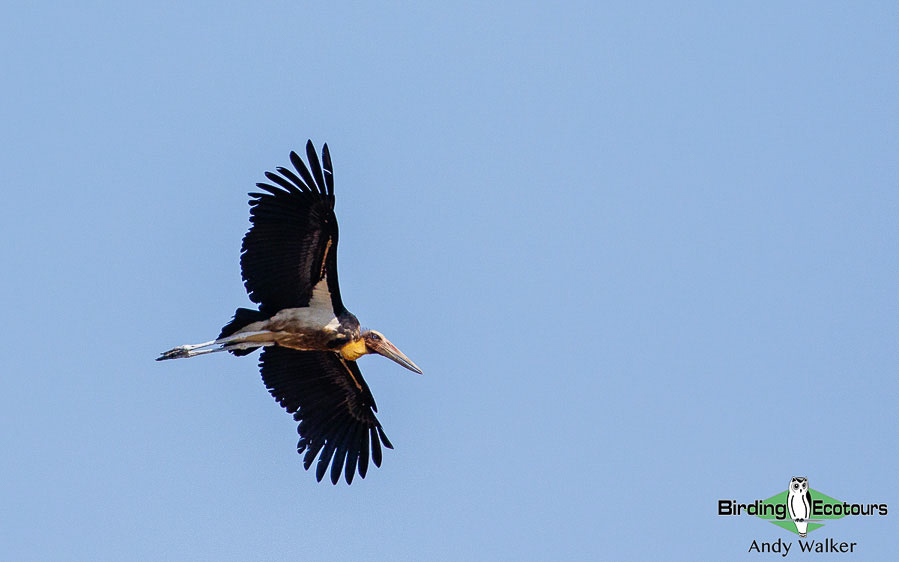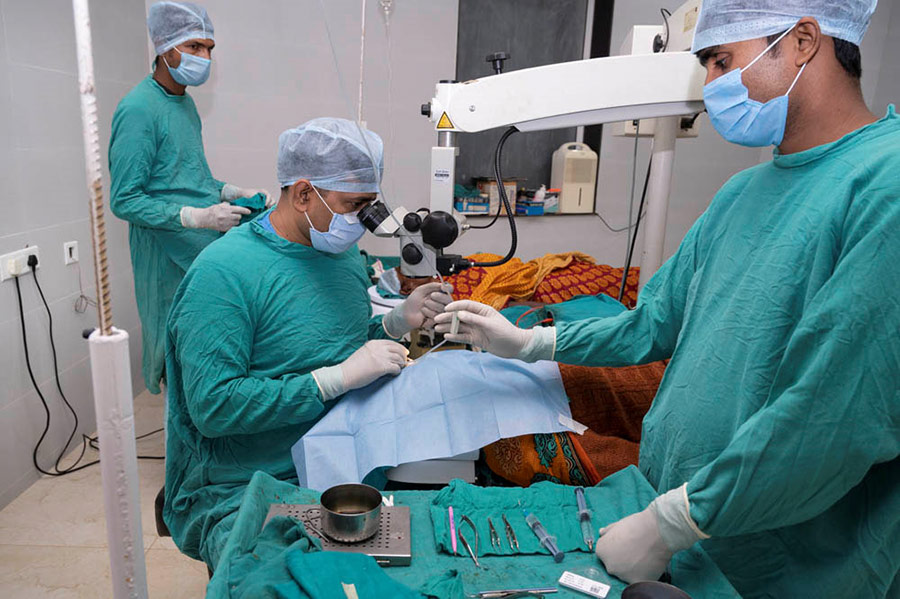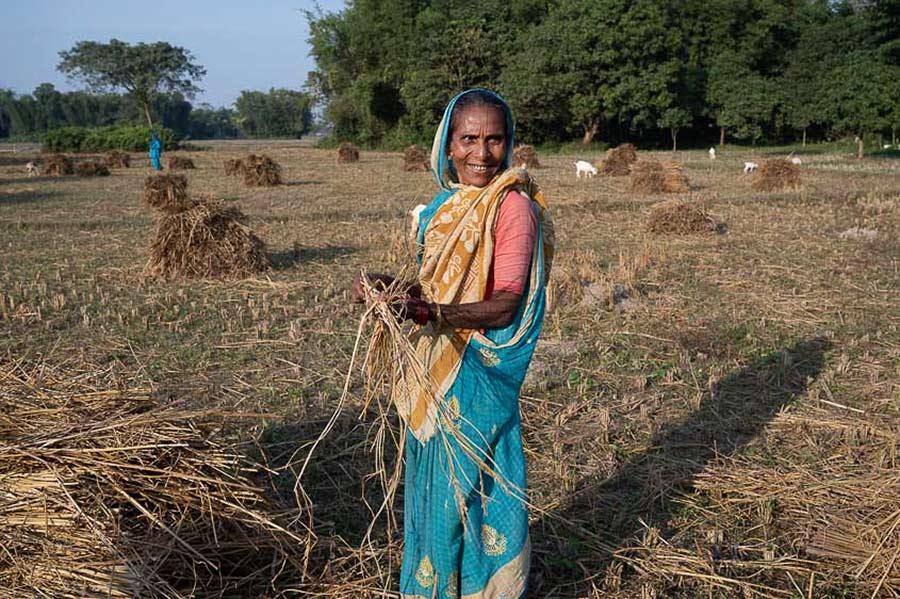By Dr Lucy Mathen, uploaded 08 April 2024
‘The Adjutant half turned his head, sheered a little in the direction of the voice, and landed stiffly on the sand-bar below the bridge. Then you saw what a ruffianly brute he really was. His back view was immensely respectable, for he stood nearly six feet high, and looked rather like a very proper bald-headed parson. In front it was different, for his head and neck had not a feather to them…His legs were long and thin and skinny, but he moved them delicately, and looked, at them with pride as he preened down his ashy-grey tail-feathers, glanced over the smooth of his shoulder, and stiffened into ‘Stand at attention.’ – The second Jungle Book, Rudyard Kipling.
Kipling is describing a Greater Adjutant, and what we saw en route to a village screening camp in rural north India, was a bird with which it is often mistaken, the Lesser Adjutant. Our sighted bird had a punk tuft of feathers on its otherwise bald head and its bill was narrower than the wedge-shaped yellowed version of the Greater Adjutant. Nor did it have the characteristic pendulous pouch of that bird. However, the first impressions of both birds are the same – sheer breathtaking size. That’s what caused our collective gasp of awe and the hospital driver to slow down our vehicle.

The large Lesser Adjutant is a sight to behold!
I have been running the small sight charity Second Sight for 24 years. We work exclusively in the Indian state of Bihar – a region with over 100 million of the poorest people in India but rich in wildlife, including birds. I have always refused to appeal for funds (as other charities do) by presenting our patients as victims who, once given second sight after cataract surgery, can work, earn a living and stop being a burden on their impoverished families. Instead, I say: “…imagine being able to enjoy once more the iridescent flash of a kingfisher flying low over a river.”
Now, finally, we have a way for people to visit Bihar and to appreciate and support the combined wonders of ophthalmology and ornithology. I am delighted to have found a willing conspirator in Chris at Birding Ecotours who shares my commitment to preserving the planet, its birds and the people who live most closely with them. More later. First, let me just catalogue some of the birds that we saw on our most recent trip to rural Bihar in January 2024.
- A couple of Eurasian Hoopoes pecking the ground outside the walls of Bamdah Eye Hospital in Jamui district, southern Bihar. I love to think that this species has been here for the 130 years that this hospital has been providing eye services to the poor. (The once-common hornbills that local eye surgeon Dr Samuel Murmu and I used to watch as they gathered in the spreading fruit tree in his garden, suddenly disappeared around ten years ago.)
- Also in Jamui, Glossy Ibises who have deserted the tall palm trees, their previous gathering point, in favor of an ugly telephone mast. Each evening, they vie with noisy green parrots in a cacophony of birdcalls.
- An Indian Golden Oriole in Madhepura district, north-eastern Bihar, which caught our eye as we left the home of local ophthalmologist Dr Amit Anand.
- A Common Kingfisher executing a rather attention-seeking circular flight for us as we walked past it en route to the Anand Eye Hospital. We encountered many others elsewhere.
- A Pied Kingfisher spotted by one of our group.
- Indian Rollers galore (often confused with kingfishers).
- Egrets
- Koels
- Mynas, including Indian Pied Mynas.
- And finally, that awesome Lesser Adjutant who later flew so low over us we could make out the head hunkered into the neck, its huge wingspan, long legs and feet pointed like a ballet dancer. It chose the moment when we had identified a patient who, very sadly, was irreversibly blind in one eye, her injury to the cornea treated inappropriately by a quack doctor, reminding us all of the importance of our work.
In the north-eastern corner of Bihar, there is now an Eco Hotel called the Hotel Ananda. It sits above the Anand Eye Hospital. Both are the brainchildren of local eye surgeon Dr Amit Anand. Foregoing the usual path for Indian doctors – chasing lucrative private practice in India’s biggest cities – he set up shop here because he wanted his skills to benefit the people in the area in which he spent his childhood, one of the most deprived regions of India.
Ten years ago, he and I organized the first village screening camp. As we drove along a narrow dirt track bordering a tributary of the River Kosi, kingfishers darted alongside our vehicle, a kind of guard of honor. A local man called Vibhu was our keenest volunteer; he was sightless in one eye from a childhood injury – a peck from a ‘bagalu’ (heron). There was no Dr Amit around in those days to attempt to save his sight with surgical repair.

The power of magnification – your binoculars in the field, the operating theatre microscope at the hospital.
Madhepura’s Eco Hotel has 17 comfortable double rooms with attached bathrooms and a rooftop terrace restaurant. Like the hospital, it is powered by solar energy, and the staff encourage the protection of the environment and the promotion of healthy living. There is a lift for disabled guests, but others are urged to take stairs. The rooms are well-lit by natural light. Food served in the rooftop restaurant is organic and grown locally, in fact, by many of the families who come to Dr Amit for their eye care. Most people in rural Bihar work on the land.

Typical scenes in rural Bihar where most people live off the land.
Guests coming and going on birding tours can step through glass doors on the ground floor and watch the busy community eye hospital at work. Birders who have themselves experienced the benefits of the humdrum miracle of cataract surgery might even wish to watch an operation taking place! Dr Amit would like income from the eco-hotel to help fund vital surgery for cataract-blind patients who are simply too poor to pay. This article has probably taken you about 3 minutes to read. That’s about the time it takes him to perform a cataract operation – for about the same cost as a night’s accommodation at the Hotel Ananda, about £20.
How to get there: Flight to Delhi – Flight or train to Patna in Bihar – Train to Madhepura (telegraph-wire birdwatching all the way) – Vehicle to the Hotel Ananda. Contact: [email protected]. Tel : + 919798536178/ +919234247822
For more information, visit www.secondsight.org.uk or call +44 7957300136.
This website is full of beautiful bird pictures – none of which I possess. Chris and I both believe that to enjoy, conserve and protect the beautiful wildlife on our planet, we must champion the poorest people who do the least damage to the environment and yet whose quality of life and livelihoods are most affected by global warming and climate change.
Birding Ecotours has donated £1000 to Second Sight to help return vision to villagers in rural India. Please click here to read more about other conservation projects we participate in and have funded over the years.
